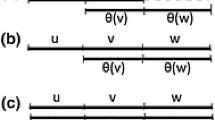Abstract
The hairpin completion is a natural operation of formal languages which has been inspired by molecular phenomena in biology and by DNA-computing. We consider here a new variant of the hairpin completion, called hairpin lengthening, which seems more appropriate for practical implementation. The variant considered here concerns the lengthening of the word that forms a hairpin structure, such that this structure is preserved, without necessarily completing the hairpin. Although our motivation is based on biological phenomena, the present paper is more about some algorithmic properties of this operation. We prove that the iterated hairpin lengthening of a language recognizable in \({\mathcal O} (f(n))\) time is recognizable in \({\mathcal O}(n^2f(n))\) time, while the one-step hairpin lengthening of such a language is recognizable in \({\mathcal O}(nf(n))\) time. Finally, we propose an algorithm for computing the hairpin lengthening distance between two words in quadratic time.
Florin Manea’s work was supported by the Alexander von Humboldt Foundation. Victor Mitrana’s work was supported by the PIV Program of the Agency for Management of University and Research Grants.
Access this chapter
Tax calculation will be finalised at checkout
Purchases are for personal use only
Preview
Unable to display preview. Download preview PDF.
Similar content being viewed by others
References
Bottoni, P., Labella, A., Manca, V., Mitrana, V.: Superposition based on Watson-Crick-like complementarity. Theory of Computing Systems 39(4), 503–524 (2006)
Cheptea, D., Martin-Vide, C., Mitrana, V.: A new operation on words suggested by DNA biochemistry: hairpin completion. In: Proc. Transgressive Computing, pp. 216–228 (2006)
Cormen, T.H., Leiserson, C.E., Rivest, R.R.: Introduction to Algorithms. MIT Press, Cambridge (1990)
Deaton, R., Murphy, R., Garzon, M., Franceschetti, D.R., Stevens, S.E.: Good encodings for DNA-based solutions to combinatorial problems. In: Proc. of DNA-based computers II. DIMACS Series, vol. 44, pp. 247–258 (1998)
Garzon, M., Deaton, R., Nino, L.F., Stevens Jr., S.E., Wittner, M.: Genome encoding for DNA computing. In: Proc. Third Genetic Programming Conference, Madison, MI, pp. 684–690 (1998)
Knuth, D.E., Morris, J.H., Pratt, V.R.: Fast pattern matching in strings. SIAM Journal of Computing 6, 323–350 (1977)
Kari, L., Konstantinidis, S., Sosik, P., Thierrin, G.: On hairpin-free words and languages. In: De Felice, C., Restivo, A. (eds.) DLT 2005. LNCS, vol. 3572, pp. 296–307. Springer, Heidelberg (2005)
Manea, F., Martín-Vide, C., Mitrana, V.: On some algorithmic problems regarding the hairpin completion. Discr. App. Math. 157(9), 2143–2152 (2009)
Manea, F., Mitrana, V.: Hairpin completion versus hairpin reduction. In: Cooper, S.B., Löwe, B., Sorbi, A. (eds.) CiE 2007. LNCS, vol. 4497, pp. 532–541. Springer, Heidelberg (2007)
Manea, F., Mitrana, V., Yokomori, T.: Two complementary operations inspired by the DNA hairpin formation: completion and reduction. Theor. Comput. Sci. 410(4-5), 417–425 (2009)
Manea, F.: A series of algorithmic results related to the iterated hairpin completion (submitted)
Sakamoto, K., Gouzu, H., Komiya, K., Kiga, D., Yokoyama, S., Yokomori, T., Hagiya, M.: Molecular computation by DNA hairpin formation. Science 288, 1223–1226 (2000)
Author information
Authors and Affiliations
Editor information
Editors and Affiliations
Rights and permissions
Copyright information
© 2010 Springer-Verlag Berlin Heidelberg
About this paper
Cite this paper
Manea, F., Martín-Vide, C., Mitrana, V. (2010). Hairpin Lengthening. In: Ferreira, F., Löwe, B., Mayordomo, E., Mendes Gomes, L. (eds) Programs, Proofs, Processes. CiE 2010. Lecture Notes in Computer Science, vol 6158. Springer, Berlin, Heidelberg. https://doi.org/10.1007/978-3-642-13962-8_33
Download citation
DOI: https://doi.org/10.1007/978-3-642-13962-8_33
Publisher Name: Springer, Berlin, Heidelberg
Print ISBN: 978-3-642-13961-1
Online ISBN: 978-3-642-13962-8
eBook Packages: Computer ScienceComputer Science (R0)




